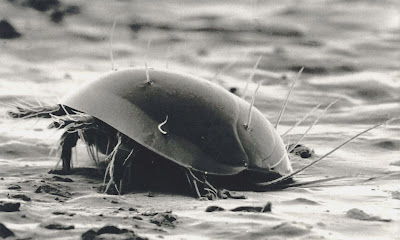For today's post, I'll be looking at a group of lacewings known as the Periclystina. Earlier posts on lacewings have looked at members of the families Chrysopidae, Kalligrammatidae and Hemerobiidae; the Periclystina belong to a further family, the Myrmeleontidae. Myrmeleontids are commonly known as ant-lions (indeed, Myrmeleon is derived from the Greek words for 'ant' and 'lion'), particularly their larvae which are fat-bodied animals with large mandibles and flip-top heads. Ant-lion larvae dig themselves into soft ground at the bottom of a conical pit; when crawling insects such as ants walk over the edge of the pit, they end up sliding down to the bottom of the cone and into the waiting jaws of the ant-lion. Ant-lions can dig themselves into the ground quite quickly; this video from Wikipedia shows an ant-lion attempting to capture prey and digging itself into the ground.
For all their charms, larval ant-lions could not be described as elegant animals. The adults, though, are as attractive as any lacewing, which is very attractive indeed. The Periclystina are a subtribe recognised by Stange (1976) within the tribe Dendroleontini of the subfamily Myrmeleontinae, and were distinguished by Stange from other dendroleontins primarily by features of the female genitalia (such as the absence of anterior gonapophyses). Stange included seven genera in the Periclystina, all of them endemic to Australia (one genus, Periclystus, has since also been found in New Guinea—New 1990). The Australian Dendroleontini were revised by New (1985), who pointed out that some of the features used by Stange (1976) to distinguish his subtribes were not entirely reliable. Though New did not formally dismantle Stange's system, it is telling that he did not make any attempt to place his own new genera within it, and Stange's subtribes may require further examination.
Many Periclystina are large and eye-catchingly patterned. The species of Periclystus are particularly remarkable with oddly scalloped ends to their wings. The irregular wing shape together with their patchy markings function to camouflage the insect when it sits along a twig. Also remarkable is Ceratoleon brevicornis, with antennae much shorter than those of any other ant-lion. Other than that, I think the pictures I'm sharing with you here largely speak for themselves.
REFERENCES
New, T. R. 1985. A revision of the Australian Myrmeleontidae (Insecta: Neuroptera). II. Dendroleontini. Australian Journal of Zoology, Supplementary Series 105: 1-170.
New, T. R. 1990. Myrmeleontidae (Insecta: Neuroptera) from New Guinea. Invertebrate Taxonomy 4: 1-20.
Stange, L. A. 1976. Classificacion y catalogo mundial de la tribu Dendroleontini con la redescripcion del genero Voltor Navas (Neuroptera: Myrmeleontidae). Acta Zoologica Lilloana 31: 261-322.































